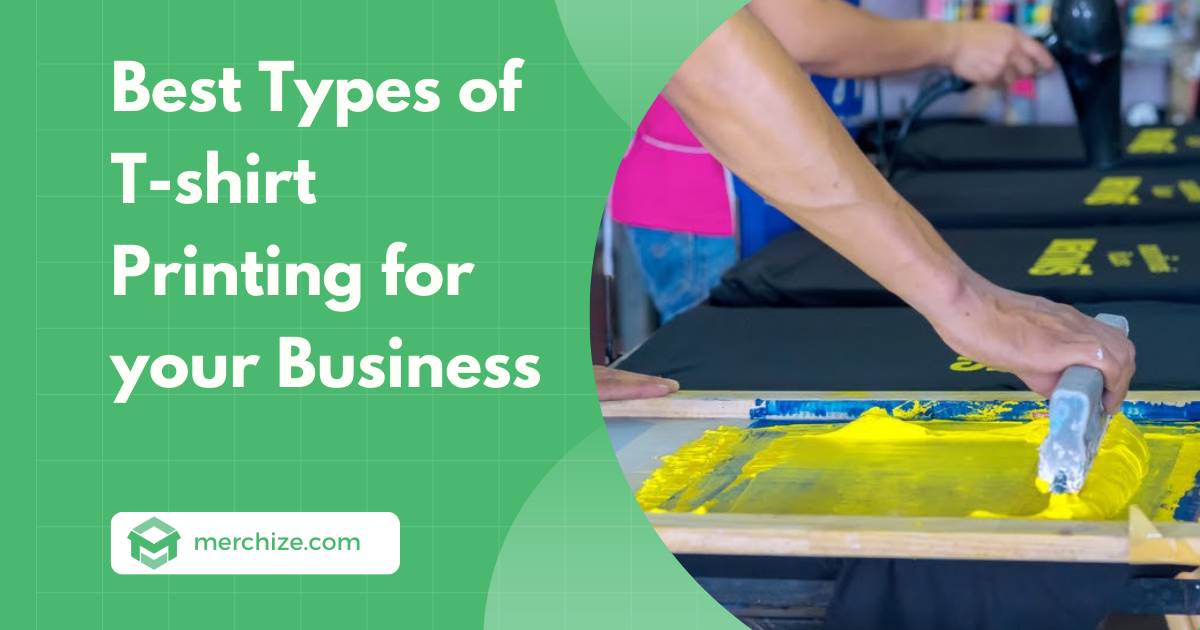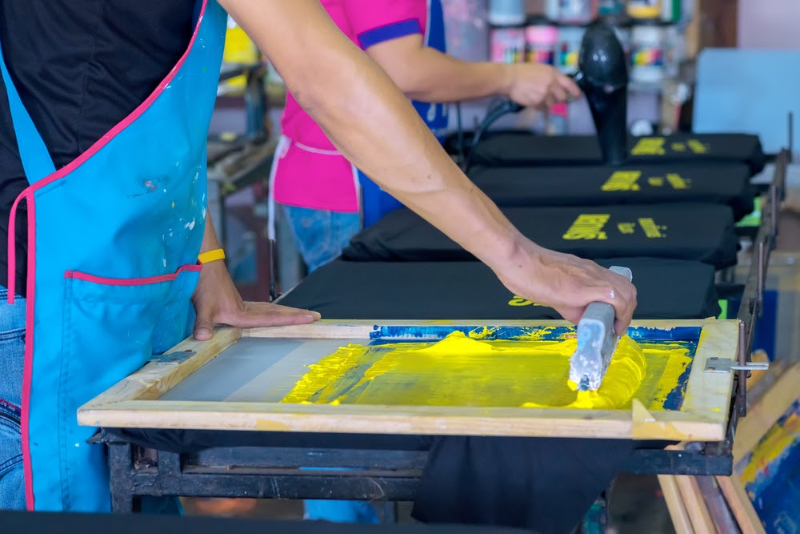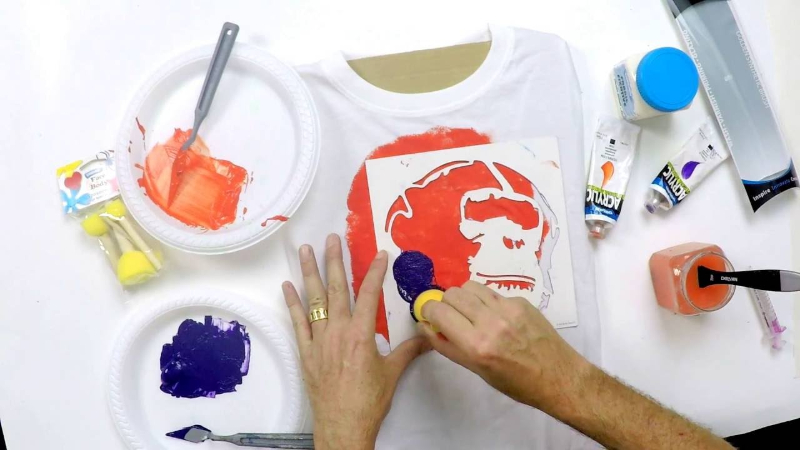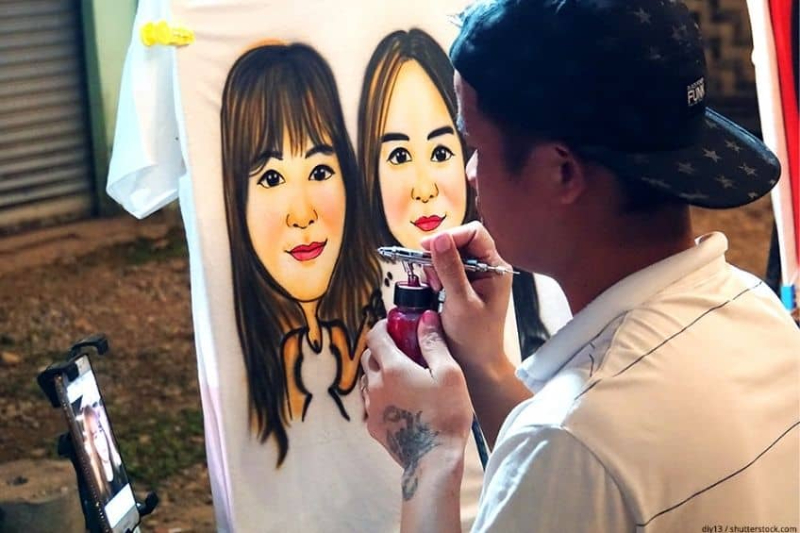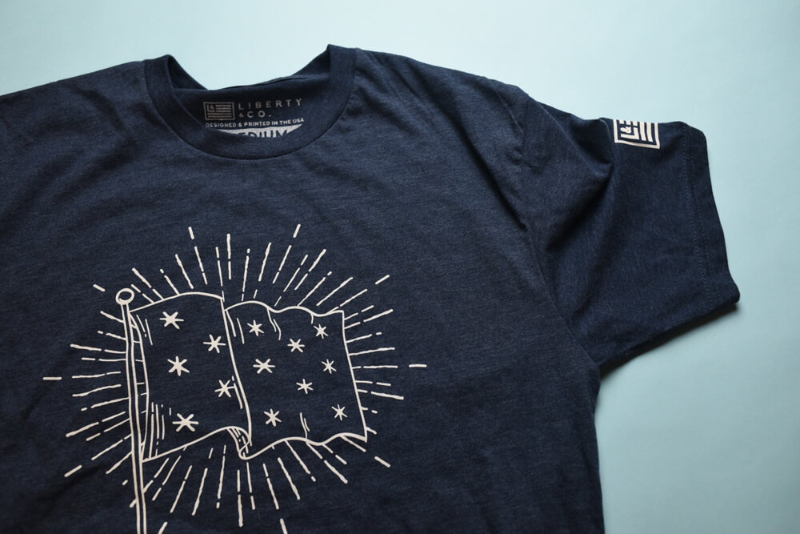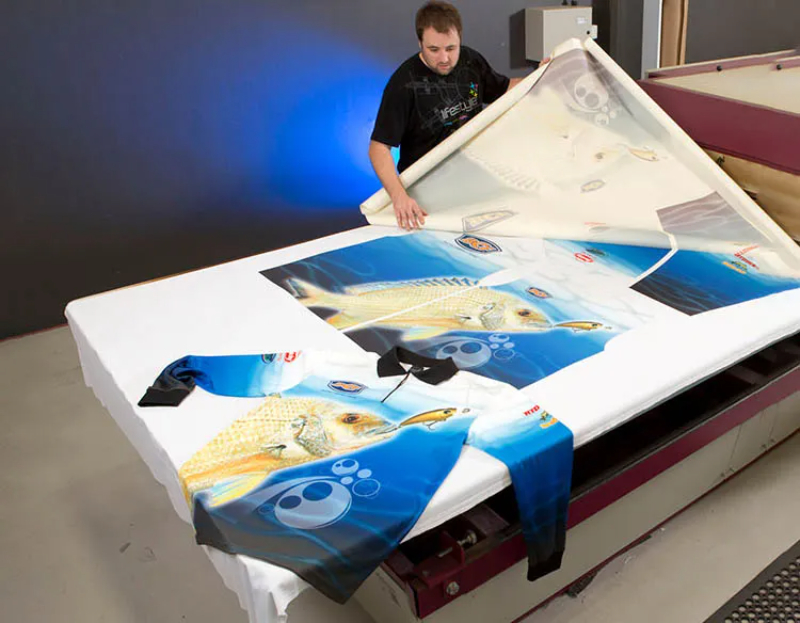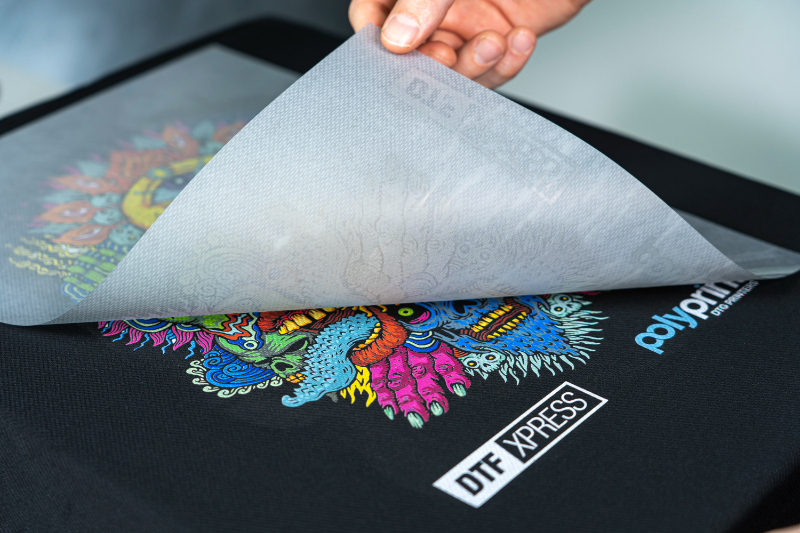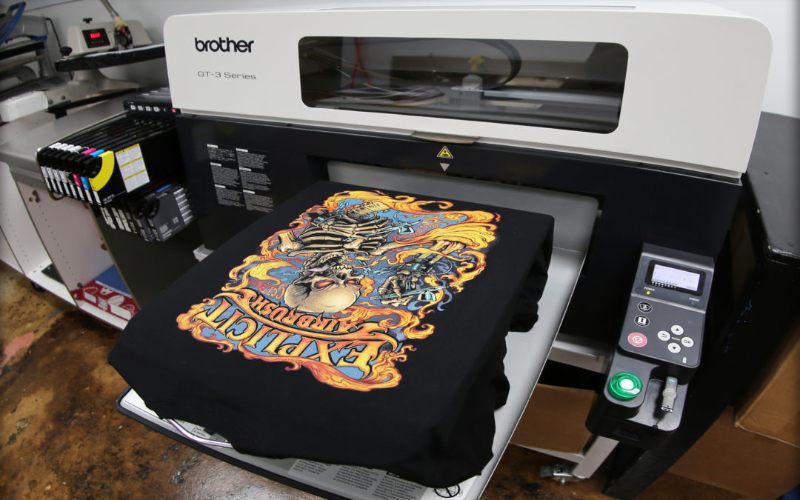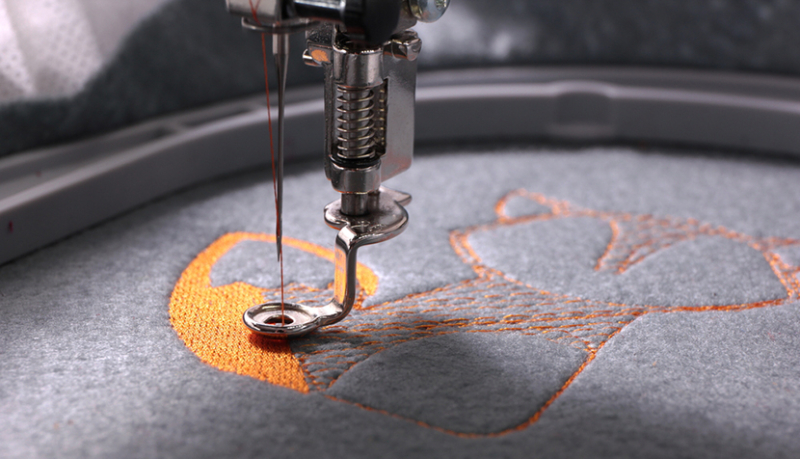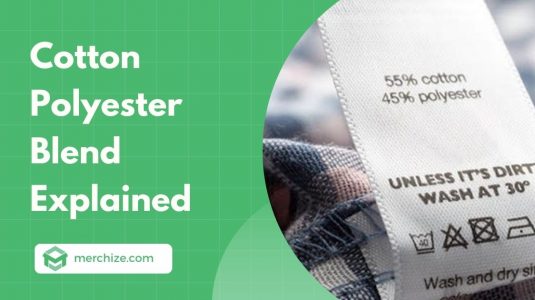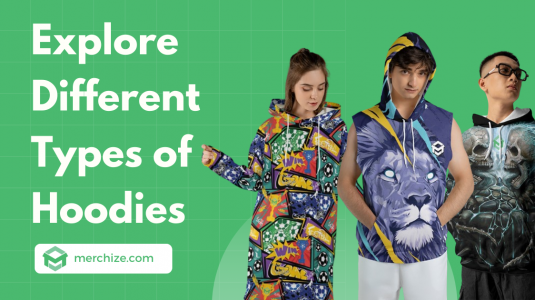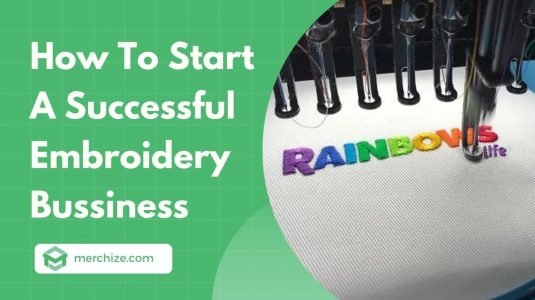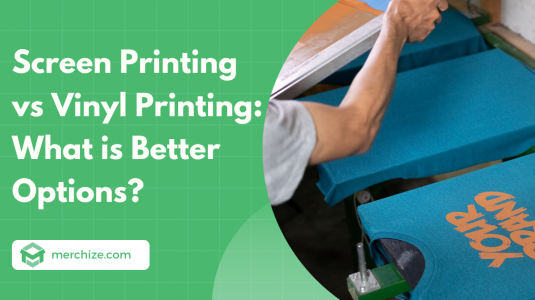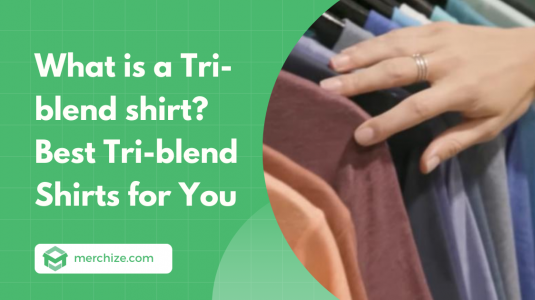Contents
Here is the most asked question for people who just starts a T-shirt-selling business: What types of T-shirt printing is the best?
There are multiple ways to create T-shirt prints. Each method comes with its own pros and cons. Let’s dive into all the popular T-shirt printing techniques and learn how to find the best option for your business.
Traditional Printing Techniques
Screen printing
Screen printing, also known as silkscreen printing, is a printing technique where ink is pushed through a stencil (a mesh screen with a design) onto the printing surface (like a t-shirt). The areas of the stencil that are not part of the design are blocked off, so the ink only goes through the negative areas of the mesh screen that correspond to the design.
This printing method is widely used for a long time due to its simplicity and high-quality printing. In the past, the screen printing process was done mostly by hand. Now, new machines are taking over in most stages of production, which cuts down on labor costs as well as time.
The ink used in screen printing is thicker and more opaque than other printing techniques, resulting in higher quality and more vibrant print.
Pros:
- High-quality and long-lasting prints: The ink is also absorbed into the fabric, which means that it won’t peel or fade easily. This makes screen printing a popular choice for t-shirts and other apparel that will be worn frequently.
- Vibrant colors and unique printing effect: The ink used in screen printing is thicker, which gives it stronger vibrancy. It’s also why screen printing can be used on both light and dark-colored fabrics to produce vivid and eye-catching designs
- Can be used on a variety of fabrics: Screen printing can be used on cotton, polyester, and blends, which makes it a popular choice for a wide variety of apparel and promotional products.
- Fast process: Quick process allows you to print a large number of products within a short period of time.
- Cost-effective for large orders: Screen printing is a cost-effective choice for larger orders of t-shirts. After the initial set-up, you can reuse it to print as many products as you wish. The setup costs can be spread out over a large number of prints, which means that the cost per t-shirt decreases as the number of t-shirts ordered increases.
Cons:
- Limited printing area: The printing area is restricted to the size of the stencil. Screen printing won’t be able to cover the entire fabric.
- More labor-intensive than other printing techniques: Screen printing requires a lot of manual labor compared to other newer modern printing techniques. Preparing the stencil, aligning the design, and applying the ink – all of these steps require human involvement.
- Limited color options: Each color requires a separate screen and printing pass. The more colors you want to print, the more screens and labor it takes to transfer your designs onto the fabric. It is also hard to portray intricate colors accurately and consistently. That’s why screen printing is only used for designs with a few simple colors.
- Not cost-effective for small quantities of T-shirts: This printing technique requires extensive setup for each individual design. You must pay for screens, emulsion, coating tools, inks, etc. For a small batch of t-shirts, it wouldn’t be economical to use screen printing.
Stenciling
Stenciling is a simple form of screen printing that requires only a few simple tools and setups to print a design.
There is no need for a silkscreen or special tool. Anything that will give the negative space prints will do. You can either cut out the design by hand or use your Cricut at home. The next step is to apply your ink over the stencil.
This traditional printing method would not secure the best printing quality yet it is super simple and fun for anyone to try at home. Professionals, on the other hand, might want to switch to other methods that are suitable for bulk printing and better quality.
If you want to do a fun DIY project at home to make a few T-shirts for your family and friends, stenciling is a good option to try out.
Pros:
- Versatility: Stencil printing allows for flexibility in design and creativity. Various materials can be used to create stencils, enabling the printing on different surfaces, including fabric, wood, walls, and more.
- Low cost: Stencil printing can be a cost-effective method since stencils can be made from inexpensive materials, such as cardboard or acetate sheets. It is particularly beneficial for one-time or occasional projects.
- DIY-friendly: Stencil printing is accessible and achievable for do-it-yourself enthusiasts. With simple tools and materials, individuals can create their own stencils and print personalized designs on various items.
Cons:
- Limited details: Stencil printing may have limitations when it comes to intricate details or complex designs. The cut-out sections in the stencil restrict the level of intricacy that can be achieved in the final print.
- Time-consuming for multi-colored prints: Stencil printing requires individual stencils for each color used in the design. This can be time-consuming when working with multi-colored prints, as each color requires a separate application and drying time.
- Not suitable for large quantities: Stencil printing is generally more suitable for smaller quantities of prints due to the manual process involved. It may become time-consuming and labor-intensive when attempting to produce large quantities.
Airbrush
Airbrushing is a unique printing technique that requires a certain level of craftsmanship and creativity to make.
Unlike other printing methods, you are not relying on any printing tools but your own hands. Yes, with this printing technique, you will spray paint directly onto the fabric. The fine mist of pain creates smooth and precise strokes on the surface.
For this printing technique, you will need an airbrush tool that consists of a nozzle and a compressor that propels the paint or ink through the airbrush tip, allowing for controlled and detailed application.
Pros:
- Precise and detailed: Using airbrushing, the artist has precise control over the application of paint or ink to create special and intricate details like smooth gradients or shading. It is the best printing technology out there to create seamless and smooth gradient effects, layer and build up the colors.
- Versatility: Airbrushing can be applied on various surfaces, including paper, canvas, metal, plastic, and even fabrics. Whether you want to create T-shirt prints, customize vehicles, do body art, etc, airbrushing can do it all.
- Room for creativity: With this printing technique, artists are able to experience and turn their vision into art.
Cons:
- It takes time to learn and practice to achieve consistent spray patterns, control the flow of paint or ink, and master the art of airbrushing. It’s hardly possible to make stunning airbrushing paint on the first try.
- Not durable print: Airbrush paint can be washed out easily and can not last very long. It is not a practical way to make T-shirts for daily use.
- Not suitable for large orders: Since the print is done by hand, it would take a long time to make a large order. Moreover, it is also hard to create consistent results throughout the process.
In conclusion, airbrush is best for DIY unique, intricate T-shirt designs but unsuitable for mass-produced orders.
Discharge Printing
Discharge Printing is far less popular than DTG or Dye Sublimation. But if you are looking for a printing method that results in unique-looking prints, discharge printing is the right choice for you. This printing method is mostly used to create vintage-looking T-shirts (which are always on trend).
Heat Transfer Printing Techniques
Unlike the traditional printing methods mentioned above, with heat transfer printing, you won’t apply ink directly onto the fabric. Instead, your designs will be printed onto a transfer paper or film first and then transferred onto the fabric using heat and pressure.
Heat Transfer Printing Techniques are preferred methods for making T-shirts as they are extremely versatile. It is applicable to different materials and can adapt to larger printing areas.
Dye Sublimation (AOP)
Dye Sublimation is a popular printing option for printing T-shirts. Technically, Dye sublimation shares the same mechanism as other transfer printing techniques: Design is transferred from a heat transfer paper onto the fabric surface.
But there is a slight difference: This method uses a special sublimation ink that turns into gas under heat, which makes it easy for the ink to penetrate into the material. As a result, the print bends with the fabric rather than sitting on the surface, creating a durable and long-lasting design.
This printing technique is suitable for synthetic fibers like polyester, spandex, and blends. The higher the polyester content percentage, the better the print quality.
Pros:
- Durable prints: Dye sublimation prints resist fading, peeling, and wearing out very effectively. The print can last a long time despite repeated washing, exposure to sunlight, and all wear and tear in general. This is the perfect type of T-shirt printing, especially for making every day T-shirts.
- High-quality print: With dye sublimation, you can get prints with intricate details with beautiful vibrant colors. Also, it is effective for reproducing photos and complex designs with precision.
- Best for AOP: Unlike traditional printing methods, this type of printing can cover a large area of fabric, which makes it the suitable option for making all-over print products. Designs will be printed on a large sheet of fabric, then cut and sew into complete products.
Cons:
- Not compatible with natural fibers: Dye sublimation is most effective on polyester fabrics or materials with a polymer coating because the special ink used for dye sublimation is made to bond with polyester molecules. That’s also why natural fibers such as cotton or silk are not compatible with this type of printing.
- Costly equipment: Dye sublimation printing requires considerable initial investment for printing equipment like sublimation printers, heat presses, inks, etc. It doesn’t stop there. In order to make an AOP T-shirt, you also have to cut and sew the fabrics into the final product, which adds more costs in the making. For this reason, this type of printing is most suitable for businesses and individuals who own large-scale production.
Other than T-shirt printing, this printing technique is also applicable to a wide range of apparel and decoration products. Look for more new and exciting sublimation products, look up our list of all Dye Sublimation products.
Direct-to-film (DTF)
Direct-to-film is one of the latest technologies to innovate the printing industry. This new method of printing uses eco-friendly water-based inks and requires no pre-treatment, allowing a more versatile and efficient process.
This new printing method can be described as a bridge between Direct-to-garment and Direct to Garment.
Similar to other transferring printing methods, Direct-to-film printing uses a special PET film (Polyethylene Terephthalate) for transferring prints into the fabric. Thermo-adhesive power then is applied to the film and heat-pressed to the final substrate, resulting in vibrant and detailed prints.
On the other hand, Direct-to-film printing is similar to Direct to garment printing as it is applicable to a wide range of materials, including both polyester and cotton fabrics.
Pros:
- Versatility: This printing method is preferred over other traditional printing as it is compatible with various fabric options, be it natural or synthetic, which leads to more production possibilities.
- Durability: Direct-to-film printing is widely recognized for its outstanding durability against washing and stretching. It can last longer, regardless of the material choices.
- High-quality printing: While meeting the requirements of being versatile and durable, DTF also doesn’t compromise printing quality. It provides bright and beautiful and vibrant prints that won’t wash out after repeated washing.
Cons:
- Limited printing area: The printer can only cover a certain area but not the entire fabric, which is similar to DTG printing. For this reason, it is best applied for printing T-shirts, pillowcases, tote bags, etc. This printing option isn’t suitable for AOP products.
- Complicated process: Compared to Dye sublimation or DTG printing, DTF can be a bit more complicated with the addition of film, adhesive powder, and so on.
Digital Printing Techniques
Digital printing refers to all printing techniques that produce printed materials from digital files. This set of technologies ditches all the manual processes or traditional printing plates. Instead, the printing process is digitalized and mechanized to be faster and more cost-effective.
Heat transfer printing techniques are also a type of digital printing. Yet, there are still a few other options that are used for printing on various materials.
Direct-to-garment printing
Direct-to-garment or DTG printing is specifically designed for printing designs directly onto garments, such as t-shirts or hoodies. This printing method uses inkjet printers and water-based inks to directly print designs onto the fabric. The result is high-quality highly detailed, colorful prints on textiles. It is a preferred method of printing for translating complex designs or images into prints.
Another peak of this printing method is the low-cost production. It might be a bit pricey at first for the initial purchase but in the long run, the cost is incredibly cheap compared to other methods. Plus, it is also suitable for making smaller, custom orders.
Pros:
- Good quality printing: DTG is a great solution for making highly detailed and colorful designs.
- Fast production: Among the fastest printing technique. It does not require a complicated setup and process. A product can be easily printed within a few minutes.
Cons:
- Only compatible with cotton fabrics: This Direct-to-garment printing is only suitable for cotton material or high cotton content fabrics.
- Not durable: DTG print is not made to last no matter what. If washed repeatedly or worn frequently, the printing quality goes down quite fast. For this reason, these DTG t-shirts are best suitable for promotional products, team uniforms, corporation or event gifts, etc.
- Not suitable for AOP: DTG printers only provide a limited printing area which is more or less around 16×20 inches. It cannot cover the entire fabric, which is why DTG is not suitable for All-over print. Moreover, DTG works best on flat surfaces. But when it comes to irregular surfaces like sleeves or collars, it shows weakness. In this case, dye sublimation is the better option.
Embroidery
Technically, embroidery wouldn’t be qualified to be classed as a printing method as it does not work with ink but stitches. However, it is still a popular option to decorate and add designs to versatile products like T-shirts.
Embroidery can be done either by hand or by machines. For larger-scale production, embroidery machines are preferred. Embroidery machines will translate your digital files into embroidery patterns and stitch them onto the fabric.
Pros:
- Durability: Embroidery creates designs that are highly durable and long-lasting on T-shirts. The stitching is secure, ensuring that your design will withstand the test of time, even after multiple washes. It sticks with the materials through thick and thin.
- Unique hand feel and texture: Delicate stitches adds texture to the blank fabrics and create an interesting hand feel to the product.
- Polished and elegant look: Compared to ink-based printing methods, embroidery offers a much more intricate, polished look.
Cons:
- Expensive cost: Embroidery, even when done by machine, can be quite expensive compared to other printing methods. It takes longer to prepare and finish. But, it should be noted that embroidery lasts longer and the result is much more sophisticated. Customers are also willing to pay more for embroidered T-shirts than regular printed ones.
- Limited colors: Stitch, unlike ink, can’t be blended to create new colors. Embroidery machines are usually limited to a certain number of thread colors. Designs for embroidery therefore should consist of colors that are available in the thread palette.
- Smaller design area: With embroidery, you can only cover a smaller portion of the fabric compared to other ink-based printing methods. This limitation is not only the result of technical hindrances but also because of aesthetic reasons. An embroidery that covers a large area of fabric will make the fabric heavy, less stretchy, less soft, or even itchy to wear.
How to find the best types of T-shirt printings?
Each printing method has its pros and cons. It’s entirely up to your demands and specific requirements to filter out what printing option works best for your T-shirt business.
Design
Knowing how you want your designs to appear on fabrics has an important role in determining what printing options to go with. Besides, the printing methods that give you more creative freedom to create the desired looks are the best. Whether you want to create simple or complex designs, they can handle it for you.
For example, if you want to print simple designs with a few colors, screen printing or other stencil printing can meet the bars. However, if you want to execute some intricate, complicated designs, other capable options like Digital Printing or Dye Sublimation are better. And it is your intention to make T-shirts fully covered with stunning designs, then you must go with dye sublimation.
Quality and durability
Naturally, you will want the best printing quality possible. The higher quality of the print, the better it looks and the longer it last.
Dye sublimation is known as the best printing method when it comes to print quality. This technique can make vibrant and colorful prints that can stay intact despite repeated washing and wearing. If you want to create T-shirts that are meant to last, choose dye sublimation.
Cost
To estimate the real cost of each printing method, you must take into account a few factors: initial equipment costs, recurring costs for inks and other materials, and the printing volume.
Some printing method costs a lot in the beginning due to big investment in machines and tools. But the more quantity, the lower cost per item.
If you only make a small number of T-shirt orders, it’s the better option to stick with traditional printing methods like screen printing or stencil printing. However, if you expect to print T-shirts in large numbers, then Digital printing like DTG or Dye Sublimation Printing makes more sense.
Time
Time is money. The faster the printing process is, the more you save and the more efficient your business is.
With the help of machines and automatic printing, you can cut down a lot of time for making T-shirts. DTG or Dye sublimation printings take only a few minutes to turn your design files into real printing.
On the other hand, traditional options take forever to set up. That being said, it is pretty fast to print a larger amount of items.
Skills
Some manual printing methods like airbrushing or screen printing might require a certain level of skills to master. While other digital options like dye sublimation and DTG do not require you to work labourously with your hands, they still require you to learn how to operate printing machines and processes.
Types of fabric
T-shirt material is a factor that determines the printing option to go with. For example, cotton fabrics won’t be compatible with dye sublimation. But polyester fabric will work best for dye sublimation material.
Each type of fabric will have its own characteristics that heavily impact the overall wearing experience. Cotton is more breathable and soft. Polyester is strong and durable, however, it is not as airy as cotton and blend materials. Make sure you understand the nature of each fabric type in order to decide on the right material and the corresponding printing techniques.
Best T-shirt printing methods at home
Running a T-shirt printing factory at home can cut down the production cost significantly. Moreover, it gives you more control over the entire process. With all the necessary tools at hand, you can let your creativity run wild and make any design, at any quantity. Asides from your own T-shirt business, you can also take in orders from other businesses and pocket more profits.
However, printing T-shirts come at a price – it will cost you a good amount of money invested in buying equipment and materials, not to mention the time it requires to work on setting up and printing.
For a home printing business, you might pay attention to the setup cost and the printing quantity to decide which is the most suitable printing technique for your business.
- Heat Transfer Vinyl: Heat transfer method is a popular choice among small t-shirt printing businesses. It’s relatively easy to get started with HTV, and it allows for intricate designs and multi-color prints. With a heat press or even a household iron, you can create personalized T-shirts with crisp and vibrant designs.
- Screen Printing: Although traditionally associated with commercial printing, screen printing can also be done at home with a little practice. It involves creating a stencil on a mesh screen and then using a squeegee to push ink through the screen onto the fabric. Screen printing provides durability and excellent color saturation, making it a popular choice for those looking to create multiple copies of the same design.
How to print on T-shirts at home
Printing your own T-shirts at home can be an exciting and fulfilling endeavor. With the right printing method, equipment, and a dash of creativity, you can turn your humble abode into a bustling t-shirt manufacturing hub.
Find the best type of T-shirt printing for your business:
Consider factors like cost, complexity, desired outcome, and the materials you’ll be working with. Popular methods for home-based printing include heat transfer vinyl (HTV) and screen printing as mentioned above. There are also plenty of other options that you can consider. Choose the method that aligns with your budget, skill level, and the type of designs you want to create.
Prepare your equipment and materials:
Once you’ve selected your preferred printing method, it’s time to gather your equipment and materials. This may include a heat press or iron for HTV, screens, squeegees, and inks for screen printing, fabric paint, stencils, and brushes for fabric painting, inkjet printer, transfer paper, or anything it takes to keep your factory running.
It should be noted that to print T-shirts at home, you need to set up a dedicated space or room to place equipment and store materials and stock. The space should be ample to accommodate your printing setup and properly ventilated to keep the unpleasant smells of printing ink away.
Learn how to set up and operate the machine:
After getting the right space and right tools, it’s time to familiarize yourself with the setup and learn how to make it work.
Read the instruction manuals, watch tutorials, and practice with scrap fabric or test prints. Understanding the nuances of your equipment will help you achieve optimal results and avoid any printing mishaps. Remember, practice makes perfect!
Test printing
Before diving into full production and avoiding all the possible errors before rolling out in full scale, it’s wise to carefully test printing. Experiment with different settings, colors, and designs to fine-tune your process.
This step allows you to identify any adjustments needed, such as adjusting temperature or pressure for heat transfers, ensuring proper ink consistency for screen printing, or refining your painting techniques. Testing will help you gain confidence in your skills and ensure that your final prints meet your expectations.
Roll out your production
Once you’ve perfected your printing technique and feel confident in your abilities, it’s time to roll out your production. Take your time to carefully set up each print, paying attention to alignment, color choices, and overall design aesthetics. Whether you’re creating a small batch of custom t-shirts or embarking on a larger project, maintain consistency in your prints to ensure a professional-looking final product.
With all these types of T-shirt printing, you can find the best options that fit your budget, your business scale, and your T-shirt design styles.
